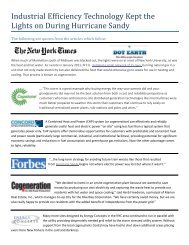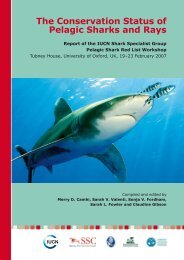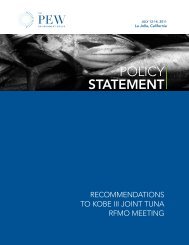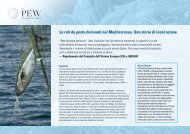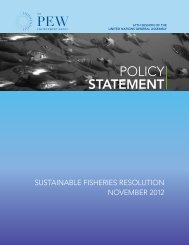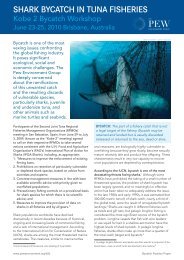The Law That's Saving American Fisheries - Ocean Conservancy
The Law That's Saving American Fisheries - Ocean Conservancy
The Law That's Saving American Fisheries - Ocean Conservancy
You also want an ePaper? Increase the reach of your titles
YUMPU automatically turns print PDFs into web optimized ePapers that Google loves.
<strong>The</strong> 35-year bATTle to end overfishing<br />
<strong>The</strong> drafters of the Magnuson-Stevens Fishery<br />
Conservation and Management Act 9 wanted more<br />
than an end to overfishing (taking fish faster than<br />
they can reproduce) by foreign fleets in U.S. waters. <strong>The</strong>y<br />
also wanted to rebuild stocks so that <strong>American</strong> fishermen<br />
could prosper. 10<br />
In order to involve fishery participants in the management<br />
process, the authors created a system of eight<br />
regional fishery management councils. Fishing stakeholders<br />
from diverse communities, sectors, and interests are<br />
nominated by governors to serve on the councils. <strong>The</strong>se<br />
bodies develop plans and recommend management<br />
measures, which are then approved by the U.S. secretary of<br />
commerce and promulgated as regulations.<br />
For the first 20 years of U.S. fishery management, the law<br />
broadly mandated that the councils prevent overfishing. But<br />
neither the law nor agency guidelines included a specific<br />
and effective set of tools for ensuring that the councils or<br />
the National <strong>Ocean</strong>ic and Atmospheric Administration’s<br />
<strong>Fisheries</strong> Service actually halted the practice. Without<br />
a clear requirement for firm catch limits, accountability<br />
measures, or action in keeping with scientific advice, chronic<br />
overfishing reached crisis proportions in many U.S. fisheries.<br />
By the 1990s, coastal communities faced depletion of<br />
important fish populations, including New England cod and<br />
yellowtail flounder; mid-Atlantic summer flounder; Gulf of<br />
Mexico red snapper; Pacific coast rockfishes; and swordfish.<br />
<strong>The</strong> Sustainable <strong>Fisheries</strong> Act of 1996 attempted to tighten<br />
the restriction on overfishing by requiring councils to<br />
establish an objective definition of overfishing in each<br />
fishery management plan. 11 But the changes, together with<br />
the decisions of officials implementing the new requirements,<br />
still allowed overfishing to continue in far too many<br />
instances. Managers often failed to set limits or ignored<br />
scientific advice in setting them. And, most importantly,<br />
there was little accountability if catches exceeded limits.<br />
Ten years after passage of the mandates, overfishing was<br />
still a big problem.<br />
It would take another decade, and recommendations from<br />
two blue-ribbon panels created to assess the health of<br />
America’s oceans, before Congress took decisive bipartisan<br />
action to address the shortcomings in the Sustainable<br />
<strong>Fisheries</strong> Act. 12 <strong>The</strong> failure to end overfishing fueled the<br />
debate over fishery management in 2006, and the clear<br />
intent of Congress in the Magnuson-Stevens Act reauthorization<br />
that year was to end overfishing by requiring catch<br />
Evolution of provisions to secure sustainable U.S. fisheries<br />
Fishery Conservation and<br />
Management Act of 1976<br />
Declared 200-mile<br />
fishery conservation<br />
zone.<br />
Created regional council<br />
system<br />
Called for sustainable<br />
management that would<br />
prevent overfishing<br />
Gave councils authority<br />
to modify maximum<br />
sustainable yield<br />
“by any relevant<br />
social, economic or<br />
ecological factor.”<br />
>> >><br />
Sustainable <strong>Fisheries</strong> Act<br />
of 1996<br />
Set maximum sustainable<br />
yield as a limit but disallowed<br />
overfishing for economic or<br />
social reasons<br />
Required management plans<br />
to define overfishing using<br />
objective and measurable<br />
criteria<br />
Called for annual report on<br />
status of stocks<br />
Established deadline for ending<br />
overfishing and rebuilding<br />
depleted populations, with<br />
some exceptions<br />
Magnuson-Stevens<br />
Reauthorization Act<br />
of 2006<br />
Mandated annual catch<br />
limits in management<br />
plans<br />
Required councils to heed<br />
recommendations of<br />
scientific advisers<br />
Added requirement for<br />
accountability measures<br />
to ensure that objectives<br />
are met<br />
Required managers to end<br />
overfishing within two<br />
years<br />
12 It’s a Keeper



